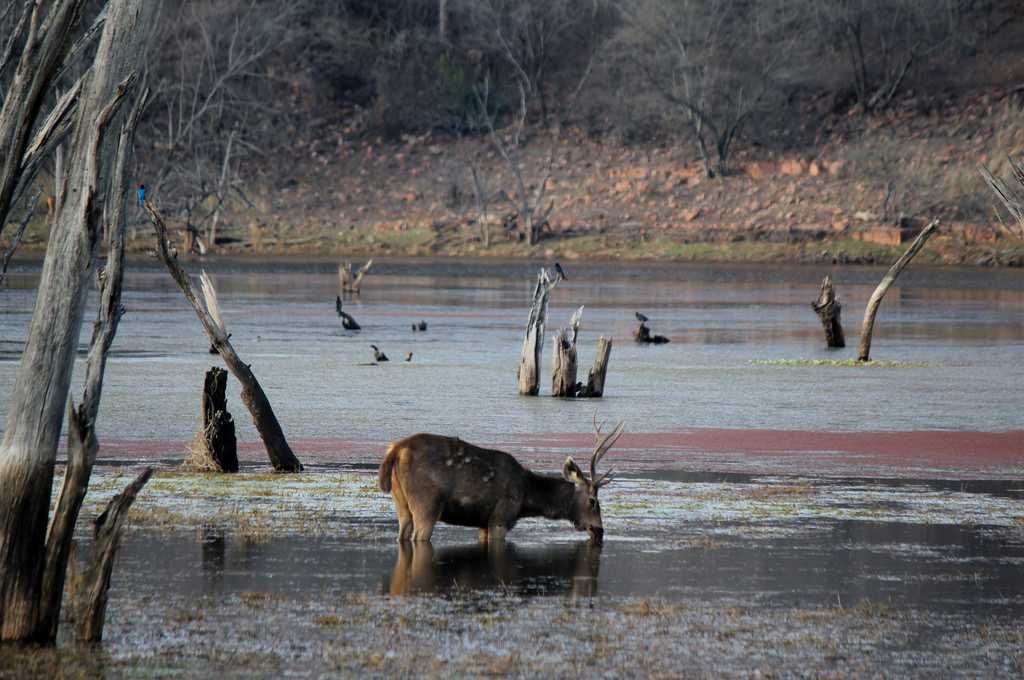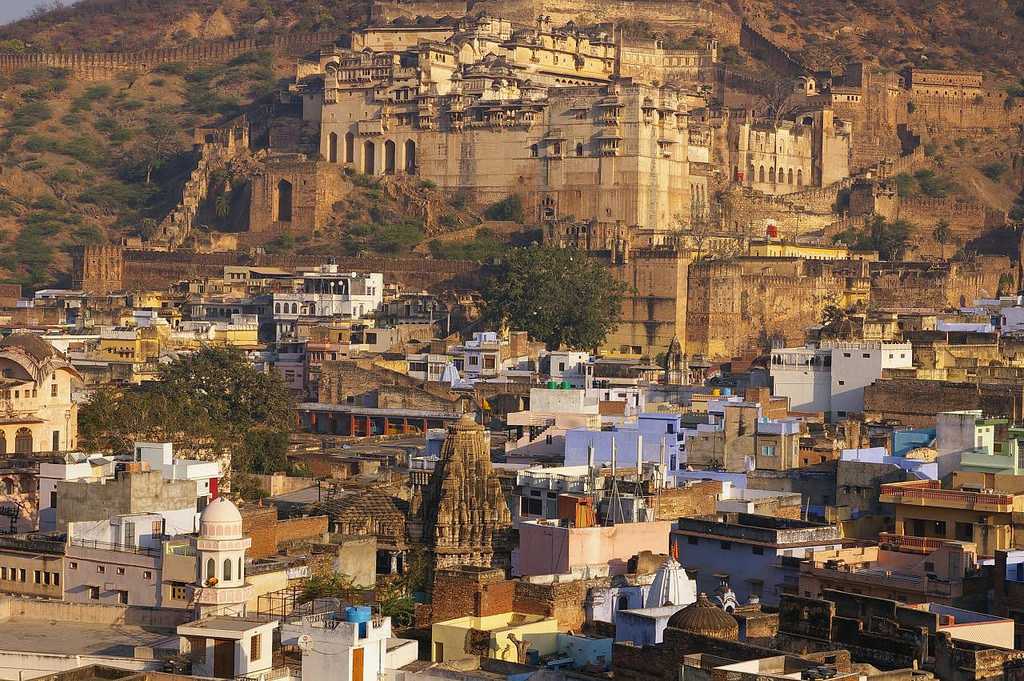RANTHAMBORE
Are you tired of the daily grind? Do you feel like you need a break from the monotony of life? Well, then it's time for a wild adventure in Ranthambore! This National Park in Rajasthan is home to the majestic Royal Bengal Tiger, among other incredible flora and fauna.
But wait, there's more! Ranthambore Fort, a UNESCO World Heritage site, is nestled inside the park and offers breathtaking views of the surrounding landscape. And if history is your thing, then you'll love exploring this ancient fort that has stood the test of time.
Now, let's talk about the real reason why we're here - the tigers! Imagine hearing their roar echo through the jungle as they roam free in their natural habitat. It's truly an experience like no other. And if you're lucky enough, you might even catch a glimpse of a mother and her cubs!
But don't worry, it's not all about tigers. The park is also home to leopards, sloth bears, crocodiles, and over 300 species of birds! Whether you're an animal lover or just in need of some nature therapy, Ranthambore has something for everyone.
So pack your bags and get ready for an adventure that will leave you with memories to last a lifetime. And who knows, maybe you'll even have a tiger sighting story to tell at your next party!
Table of Contents
- Introduction
- History and Culture of Ranthambore
- How to Reach and getting around Ranthambore
- Weather of Ranthambore
- Places to Visit in Ranthambore
- Food Options and Local Cuisine of Ranthambore
- Best areas for Accommodation in Ranthambore
- Shopping in Ranthambore
- Nightlife in Ranthambore
- Festivals and Events in Ranthambore
- Tips for Travelers travelling to Ranthambore
- FAQs
History and Culture of Ranthambore
Ranthambore is a wildlife sanctuary located in Rajasthan, India. It is famous for its majestic tigers and the beauty of the surrounding landscape.
Legend has it that Ranthambore was once ruled by a ferocious tigress named Machli, who was known to hunt crocodiles and take down full-grown male tigers.
The sanctuary also has a rich history, with numerous ancient ruins and temples scattered throughout the area. It was once a hunting ground for the Maharajas of Jaipur and later became a protected wildlife reserve in 1973.
The local culture is deeply rooted in Rajasthani traditions, with colorful clothing, delicious cuisine, and lively music and dance performances.
Visitors can experience the local culture by attending traditional Rajasthani folk dances like Ghumar or Kalbeliya or by trying out authentic Rajasthani dishes like Dal Baati Churma, Laal Maas or Gatte ki Sabzi.
Aside from tigers, the sanctuary is also home to other wildlife such as leopards, hyenas, sloth bears, and various species of birds. Visitors can take Jeep safaris or canters to explore the sanctuary and spot these animals in their natural habitat.
Overall, Ranthambore offers an exciting mix of history, culture, and wildlife that makes it one of India's most popular destinations for tourists.
How to Reach and getting around Ranthambore
Ranthambore National Park is a famous wildlife destination located in Rajasthan, India. There are several ways to reach this place, and each option offers its unique travel experience.
- By Air: The nearest airport is Jaipur International Airport, which is approximately 150 km from Ranthambore. After arriving at the airport, you can hire a taxi or take a bus to reach the national park.
- By Train: Sawai Madhopur railway station is the closest railway station to Ranthambore National Park. It has direct train connections with major cities like Delhi, Mumbai, and Jaipur. From the railway station, private taxis and buses are available for tourists to reach the national park.
- By Road: Ranthambore National Park is well-connected by road with major cities like Delhi, Jaipur, and Agra. You can hire a taxi or take a bus to reach the national park from these cities.
- By Bike or Car: If you love road trips and want to experience the scenic beauty of Rajasthan, then driving your own vehicle or renting one can be an excellent option. The highways leading to Ranthambore are smooth and offer a fantastic driving experience.
- By Bicycle: For adventure enthusiasts who want to explore the region at their own pace and enjoy nature up close, cycling can be an exciting option. You can rent bicycles from nearby towns and take leisurely rides through the countryside before reaching Ranthambore.
No matter which mode of transportation you choose, each one offers its unique charm and adventure that makes your journey memorable. So pack your bags and get ready to explore this fantastic wildlife destination!
Weather of Ranthambore












 Extreme Winters
Extreme Winters Mild Winters
Mild Winters Hot + Dry
Hot + Dry Hot + Humid
Hot + Humid Rainy
Rainy Cool and Pleasant
Cool and PleasantRanthambore is a beautiful wildlife destination located in the Indian state of Rajasthan. The weather in Ranthambore is tropical and mostly hot, with temperatures soaring up to 45°C during summers. The monsoon season starts from July and lasts till September, bringing moderate to heavy rainfall. During winters, the temperature drops down to 2°C, making it quite chilly.
The best time to visit Ranthambore is from October to March, when the weather is pleasant and ideal for wildlife safaris. During this time, the temperature ranges between 10-25°C, making it comfortable for visitors to explore the park without any discomfort. The lush green forests and water bodies during this period provide a picturesque view of the park's beauty.
During summers, it becomes difficult to spot animals as they prefer staying in their dens or hiding under shades due to extreme heat. Monsoons bring heavy rainfall which may lead to roadblocks or other difficulties in movement within the park.
In conclusion, if you want to witness the best of Ranthambore's wildlife, visit between October and March, when the weather is pleasant and favorable for wildlife safaris.
Places to Visit in Ranthambore
Ranthambore National Park: Home to the majestic Bengal tigers, Ranthambore National Park is a must-visit place for wildlife enthusiasts. Spread across an area of 392 sq km, the park is also home to other animals such as leopards, sloth bears, and various species of deer.
Ranthambore Fort: Built in the 10th century, Ranthambore Fort is a UNESCO World Heritage Site that offers breathtaking views of the surrounding landscape. The fort has several temples, palaces, and other structures that are worth exploring.
Padam Talao: One of the largest lakes in Ranthambore National Park, Padam Talao is a serene spot where visitors can enjoy a boat ride and spot various species of birds such as kingfishers and herons.
Kachida Valley: Known for its rugged terrain and rocky outcrops, Kachida Valley is a popular spot for trekking and birdwatching. Visitors can also spot animals such as sambar deer and hyenas here.
Raj Bagh Ruins: Located inside Ranthambore National Park, the Raj Bagh Ruins are the remains of an ancient palace complex that dates back to the 10th century. The ruins offer a glimpse into the region's rich history.
Surwal Lake: Surrounded by lush greenery and teeming with birdlife, Surwal Lake is an idyllic spot where visitors can relax and soak in nature's beauty.
Malik Talao: Another picturesque lake inside Ranthambore National Park, Malik Talao is known for its stunning sunsets and mesmerizing reflections on calm days.
Jogi Mahal: A historic hunting lodge located inside Ranthambore National Park, Jogi Mahal offers panoramic views of the surrounding hills and valleys. Visitors can also visit nearby temples and hike to nearby waterfalls from here.
Bakaula: A lesser-known but equally stunning spot in Ranthambore National Park, Bakaula is known for its scenic beauty and diverse flora and fauna.
Chamatkar Temple: Located near Ranthambore Fort, Chamatkar Temple is an ancient Hindu temple dedicated to Lord Ganesha that attracts devotees from far and wide due to its unique architecture and peaceful ambiance.
Note: This content has been written by an AI language model.
Adventures Activities
Heritage Places
Nearby Forests
Food Options and Local Cuisine of Ranthambore
Best areas for accommodation in Ranthambore
Ranthambore is a popular destination among wildlife enthusiasts and nature lovers. The national park is home to tigers, leopards, sloth bears, and various species of birds. The best areas for accommodation in Ranthambore are:
Sawai Madhopur: This is the nearest town to the national park, and it has several hotels, resorts, and guesthouses.
Khilchipur: This area is located on the outskirts of Sawai Madhopur and has some excellent accommodation options.
Ranthambore Road: This stretch of road connects Sawai Madhopur to Ranthambore National Park and has a few hotels and resorts.
If you're looking for luxury accommodation in Ranthambore, you can consider:
- Oberoi Vanyavilas: This resort is located near the national park entrance and offers luxury tents with private gardens, a spa, and a pool.
For budget-friendly options, you can check out:
- Tiger Safari Resort: Located in Khilchipur, this resort offers comfortable rooms at affordable prices.
And if you're traveling solo or on a tight budget, you can opt for:
- Zostel Ranthambore: This hostel offers dormitory-style accommodation with shared bathrooms and a common kitchen area.
Overall, Ranthambore has something for everyone when it comes to accommodation options. Whether you're looking for luxury or budget-friendly stays, you'll find plenty of choices in this wildlife paradise.
Shopping in Ranthambore
Ranthambore, located in Rajasthan, is famous for its wildlife sanctuary and tiger reserve. Along with the wildlife, Ranthambore is also a popular destination for shopping. The shopping market of Ranthambore offers an exquisite collection of handicrafts, textiles, jewelry and souvenirs.
Things to buy
- Handicrafts- pottery, leather items, and wooden crafts.
- Textiles- Sarees, Scarfs and Quilts made from local fabrics.
- Jewelry- Silver earrings, anklets and necklaces with traditional designs.
- Souvenirs- Miniature paintings of tigers and other animals found in Ranthambore.
Markets to visit
- Ranthambhore Art Gallery - Known for its miniature paintings on silk and paper.
- Kundera Bazaar - Known for its leather products like shoes, belts etc.
- Village Women Craft - Known for its hand-woven textiles like sarees and scarfs.
What to avoid
- Ivory Products - It is illegal to buy or sell ivory products in India.
- Animal Skins - Buying animal skins or products made from them is illegal
- Counterfeit Products - Avoid buying cheap knock-offs of branded items
- Expensive Gems- Avoid buying expensive stones from unknown sources.
In conclusion, shopping in Ranthambore can be a fun-filled experience. However, it is important to be aware of what to buy and what not to so that you do not end up breaking any law or getting cheated. So plan your trip accordingly!
Nightlife in Ranthambore
Ranthambore, the land of tigers, offers an exciting wildlife experience during the day time. But, when the sun sets, it's time to explore the vibrant nightlife of this place. The nightlife in Ranthambore is not about club-hopping or partying but about enjoying the calmness and serenity of nature.
There are many activities that one can indulge in during their night stay in Ranthambore. Here are three places with some activities to enjoy a thrilling nightlife:
Ranthambore Fort: This fort is a perfect blend of history and wildlife. Take a night walk around the fort to witness the nocturnal animals such as hyenas, foxes, and even tigers. The fort also offers mesmerizing views of Ranthambore National Park at night.
Jungle Safari: Night safari is an excellent way to explore Ranthambore's wildlife after sunset. You can spot many nocturnal animals like leopards, jackals, and owls that come out after dark.
Camping: Camping under the stars is an exhilarating experience in Ranthambore. Many campsites offer camping facilities with bonfires and barbeques where you can relax with your loved ones.
Apart from these places, there are many local eateries and street food stalls where you can indulge in delicious food while enjoying the vibrant nightlife of Ranthambore.
In conclusion, if you're looking for a unique and thrilling experience amidst nature's calmness, then Ranthambore's nightlife is worth exploring!
Outdoor Activities in Ranthambore
Ranthambore is not just famous for its wildlife but also for the plethora of outdoor activities it offers. Visitors can indulge in various activities that range from thrilling jungle safaris to serene nature walks. One of the most sought-after activities is the safari in Ranthambore National Park, which allows visitors to have a close encounter with the majestic tigers and other wildlife species. Apart from this, there are several other exciting activities that one can enjoy during their stay in Ranthambore.
Nature Walks: Nature walks are ideal for those who want to explore the beauty of Ranthambore at their own pace. It is an excellent way to get close to nature and witness its wonders up close. The naturalists guide visitors through the jungle, pointing out various flora and fauna along the way.
Trekking: For adventure enthusiasts, trekking is an excellent option. Visitors can trek through the rugged terrain of Ranthambore and discover hidden waterfalls, ancient temples, and picturesque landscapes.
Bird Watching: Ranthambore is a paradise for bird watchers as it houses over 270 species of birds. Visitors can spot rare birds like Indian Pitta, Crested Serpent Eagle, and White-naped Woodpecker while walking through the jungle.
In conclusion, Ranthambore offers a wide range of outdoor activities that cater to every kind of traveler's interests. So whether you're looking for adventure or just want to relax amidst nature, Ranthambore has something unique to offer everyone.
Festivals and Events in Ranthambore
Festivals and events are an essential part of the cultural and social fabric of Ranthambore. The region celebrates various festivals throughout the year, which attract a considerable number of tourists from around the world. These festivals offer an insight into the traditions, customs, and beliefs of the locals.
Ganesh Chaturthi - September: This festival marks the birth anniversary of Lord Ganesha. It is celebrated with great enthusiasm and devotion by locals.
Dussehra - October: Dussehra is celebrated across India as a symbol of good over evil. In Ranthambore, it is celebrated with a grand procession to mark the victory of Lord Rama over Ravana.
Diwali - November: Diwali, also known as the Festival of Lights, is one of the most important festivals in India. It is celebrated with great fervor in Ranthambore, where people decorate their houses with lights and diyas.
Holi - March: Holi is a spring festival that celebrates the victory of good over evil. People celebrate it by throwing colors at each other and enjoying traditional sweets.
Teej - August: Teej is a monsoon festival that celebrates the union of Lord Shiva and Goddess Parvati. Women dress up in traditional attire and offer prayers for marital bliss.
Apart from these festivals, there are several other events that take place in Ranthambore throughout the year. These include wildlife safaris, bird watching tours, cultural performances, and adventure activities like trekking and camping.
Attending these festivals and events can be an excellent way to experience the rich culture and heritage of Ranthambore while having fun at the same time. Visitors can participate in these celebrations to understand local traditions better and interact with locals to learn more about their way of life.
Tips for Travelers while travelling to Ranthambore
Plan ahead: Ranthambore is a popular destination, especially during peak tourist season. It is advisable to plan ahead and make bookings for accommodation, safari tours and other activities in advance to avoid any last-minute hassles.
Dress appropriately: Ranthambore has a hot and dry climate, so it's essential to wear light and comfortable clothing. However, while going on safari tours, it's important to dress appropriately in neutral colors that blend with the surroundings. Avoid bright or flashy clothing that could scare away the wildlife.
Carry essentials: While exploring the national park, carry essential items like sunscreen lotion, mosquito repellent, hat or cap, sunglasses, and a water bottle. These items will help you stay comfortable and safe during your trip.
Follow the rules: Ranthambore National Park has strict rules for visitors. Follow them strictly to ensure your safety and avoid any inconvenience. Do not litter or disturb the wildlife in any way. Stay inside your vehicle during safari tours.
Be patient: Spotting tigers can be a matter of luck as they are elusive creatures. Don't get disheartened if you don't see one immediately. Be patient and enjoy the scenic beauty of the park along with its other inhabitants like deer, birds etc.
By following these tips, travelers can make their trip to Ranthambore memorable and enjoyable while also being responsible tourists who respect nature and wildlife.
FAQs
What is Ranthambore known for?
Ranthambore National Park is famous for its tiger reserve and has one of the highest densities of tigers in India. The park covers an area of around 400 sq km and is located in the Sawai Madhopur district of Rajasthan, India. Apart from tigers, Ranthambore is also home to a variety of other wildlife such as leopards, sloth bears, wild boars, hyenas, and many more.
What is the best time to visit Ranthambore?
The best time to visit Ranthambore is from October to June when the park remains open for visitors. During this time, the weather remains pleasant with temperatures ranging between 20-35°C. However, it's recommended to avoid visiting during monsoons (July-September) as the park remains closed due to heavy rainfall.
How do I reach Ranthambore?
The nearest airport to Ranthambore is Jaipur International Airport which is around 160 km away. From there, you can hire a taxi or take a train or bus to reach Sawai Madhopur which is the nearest railway station and bus stop.
What are the entry fees for Ranthambore National Park?
The entry fees for Indian nationals are INR 300 per person per safari while for foreign nationals it's INR 700 per person per safari. Apart from this, you also need to pay extra charges for hiring a jeep or canter for the safari.
Can I book a safari in advance at Ranthambore National Park?
Yes, you can book a safari in advance at Ranthambore National Park through their official website or by contacting registered tour operators. It's recommended to book in advance as there are limited seats available and they get booked quickly during peak season.
Is it safe to visit Ranthambore National Park?
Yes, it's safe to visit Ranthambore National Park as long as you follow the rules and regulations of the park. It's important not to disturb or harm any wildlife and maintain a safe distance from them.
What should I carry while visiting Ranthambore National Park?
While visiting Ranthambore National Park, it's recommended to carry light cotton clothes as well as warm clothing during winters (November-February). Other essentials include comfortable shoes, sunscreen lotion, sunglasses, insect repellent, binoculars, camera with extra batteries/ memory cards and a water bottle.

_20180902120848.jpg)


